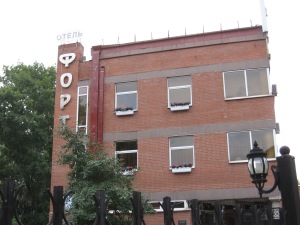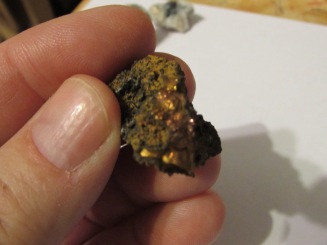
My first hotel in Ekaterinburg Russia, the Fort Hotel. I would discover that weddings and birthday parties are celebrated almost every day in hotel restaurant/celebration rooms. At one such party I saw a strange grandmother clown character entertaining the well dressed crowd.
On my way to Chelyabinsk for work, I decided to stop at Ekaterinburg and do a 3 day Mineral Tour of the Ural mountains. You see, as a child I was a fan of those extraordinary rocks that gleamed in the sunlight, stones that were clear or some color so startlingly different from the eight in my crayon box that I was mystified. I saw these rocks, these minerals, as a kind of miracle in the dirt. Yet I grew up and forgot about them, busy finding a mate and a career, living life above the ground. Only a few years back then did I rediscover my passion for minerals, while digging for clear quartz points and clusters near Hot Springs, Arkansas. And pyrite crystal collecting at Kite Lake in Alma, Colorado. And bargaining at an amethyst mine in Sidi Rahal, Morocco. And sifting thru a sand dump in Australia, finding my first genuine amethyst point.

Crystal clear points I dug near Hot Springs, Arkansas
Perhaps this is my way to prepare for life below the ground – to imagine myself one day, the minerals in my body that is, crystallized and tangled in the gnarly roots of a tree, waiting to be pried out by a child, or an old man, who will marvel at the miracle, as I do.

My first day of the Mineral Tour, digging for quartz points
Day 1:
I listen to the Russian language, on the Rossiya plane from Saint Petersburg to Ekaterinburg, and I think, if cats ever learn to speak, their first language will be Russian. Because Russian sounds like a language for cats, full of lapping happy sounds.
And come to think of it, the Russians themselves look a bit like cats. Aloof, in their own world, yet at the same time puffy and ready to purr and pounce.
I love my walks in a new country, and my first walk in Ekaterinburg is no exception. I enter a large food store (they actually use the word Market in Russian), and glow with happiness as I look over the many unique cookies and a girl working there mistakes me for Russian and begins explaining to me something about the particular cookies in front of me as opposed to the ones she is busy marking down (I suppose I look a bit the cat myself). I nod and select a package of freshly made, cellophane-wrapped, white chocolate covered maraschino cherry cookies (37.35 Rubles – $1.25).
My hotel, The Fort Hotel, is smack in the middle of miles of concrete apartment blocks.

Typical apartment house in Ekaterinburg – note the unique balconies
I look closer and notice they don’t look so much like apartments as they do compartments – they look like pre-fabricated concrete compartments stacked next to each other and then on top of each other, to make one large building after another. They are not pretty, in their gray squareness. In the US we would call them sad buildings. But here they are just where everyone lives.
(Later I learn that both Ekaterinburg and Chelyabinsk (and Miass) are fairly new cities, built at the start of World War II, with engineers and scientists, and factories, and entire cities, transported by the government from the western part of Russia that was too close to invading German forces. The Russian government picked this region to build the cities because it was so rich in minerals for building tanks and planes and everything for war. Today it houses worldclass universities – and worldclass engineers – that is one reason Rocket Software, and I, are here as well.)

My guide Nicolay and my interpreter Tanya. Note birch and fir trees.
My guide Nicolay arrives with my interpreter Tanya, and we set out on our first day of the tour in a large 4 wheel drive Lada Niva truck. I find out thru Tanya that Nicolay has 2 small mineral museums himself (I visit one later – it is actually a converted apartment on the ground floor of an apartment building, full of display cases and boxes of 30 years of mineral collecting – with some marvelous samples). He is a geologist who teaches and takes his students to some of the same mines we will visit on the tour. I also find out thru innocent questioning that Tanya is not only a sixteen year old eleventh grader (who I mistook for a 20 year old university student), she is also in fact Nicolay’s daughter. This is her first time to go along with her father as English interpreter on such a tour.
“Mostly Germans and French take this tour. You are the first American,” Tanya tells me. She also tells me there are only 11 grades in Russian school, so she is actually a senior. Next year she will go to University and study to be a veterinarian.
The first mine we visit provides a most extraordinary mineral – pyrophyllite. Pyrophyllite looks like shiny teepees of green or gold.

Pyrophyllite I found – can have green or gold teepee-like crystals
Next we searched for goethite, a mineral named after Goethe, the author of the first best selling novel in the world in 1775, called The Sorrows of Young Werther (about a young man who falls in love with a young woman who does not return his love), and also of the classic Faust (about a man who sells his soul to the Devil for unlimited knowledge and worldly pleasure). Goethite is often mistaken for gold, as it bubbles on stone as gold will do.

Goethite I found
Nicolay wanted to drop me down into a mine pit that he had dug using the old techniques, but someone had stolen the ladder.

Nicolay climbed down into this mine using the logs since someone had stolen his ladder. Very cold down there.
So he climbed down himself, to show me what it looked like working down there. When he came back up he had saved several frogs which he handed to Tanya.

Frogs saved from the mine pit
A good place to search for minerals is in old gold mine dumps, and around the vicinity of gold mines, because where there is the mineral gold, quartz, pyrite and other minerals often accompany it.

Statue of Erofey Markov – the first person to discover gold in Russia in 1745
Gold was discovered in Russia a hundred years before it was discovered in the U.S.A. On our way to the Berezovskaya Gold Mine, one of the largest and oldest active gold mines in Russia, Nicolay tells me, thru his daughter Tanya, the story of how gold was first discovered in Russia.
In 1745 simple peasant Erofey Markov decided he wanted to make a new career carving jewelry from quartz crystal. To that end he went searching on the eastern slope of the Urals and found, to his astonishment, quartz with gold in it. This was astonishing because everyone knew in 1745 that there was no gold in Russia, because gold comes from the sun, and this part of Russia has little sun, only cold.
Being a good Russian peasant, Erofey knew he must report his find to the czar of Russia, Peter the Great (who built Saint Petersburg as his new capital). The other peasants told Erofey not to tell the czar, to forget he ever found the gold. That his discovery was a disaster for the people of the region. Because if the czar found out about the gold, he would send soldiers and the soldiers would find out that the peasants in this region still worshiped in the old Christian ways – and the peasants would be forced to convert to reformed Christianity or be sent to prison camps in Siberia.
But Erofey didn’t listen and he told the czar’s representatives about his find, and down came the czar and his soldiers and geologists to see for themselves. Erofey was delighted to meet the czar, and tried his best to show him where he had discovered the gold, but unbeknownst to him the other peasants had blocked up his diggings with a ton of rock, and no gold could be found. Erofey was sent to prison in Siberia for lying to the czar, much to the delight of some of the “Old Believers” in the region.
For two long years Erofey worked at hard labor in the prison camp in Siberia, cursing the day he found that quartz-streaked gold. But a geologist of the czar believed Erofey, and after much searching and digging he confirmed Erofey’s find. Erofey was released from prison, and went to work at the first gold mine in Russia that opened in 1748.
I liked the story of Erofey and his misadventure with gold. He is now considered a hero – 200 tons of gold have come from that region, helping make the Russian government rich and powerful for 200 years. I suspect though, that there are people in the region who still curse Erofey for getting their great-great-great grandparents sent to Siberia because they refused to give up their old Christian religion and become reformed Christians (the irony being that atheism later became the state stance under Lenin-Marxism, with churches and mosques destroyed and people of all religions persecuted).

Birch trees
As we travel from mine to mine, I am struck by the forests of Birch and of Fir. Nicolay, thru Tanya, explains to me that the most famous trees from Russia are the Larch trees. Larch trees can lie in water for 300 years and not rot. The foundations of many of the palaces in Venice were built with Larch trees from Russia, as was the foundation of many of the buildings in Saint Petersburg (which was built atop a swamp).

Fir trees
Also, as we travel in the countryside past villages and towns, I am struck by entire neighborhoods of old log houses. Tiny houses by US standards, still their fronts have beautifully decorated windows, and are still lived in, 100 to 200 years after they were built. At the end of the day they drop me at my hotel. The next 2 days we will mine and camp out in the forest.

One hundred year old house
 Featured Book by Ray Else
Featured Book by Ray Else

















That was a very interesting story about finding the first gold in Russia 🙂